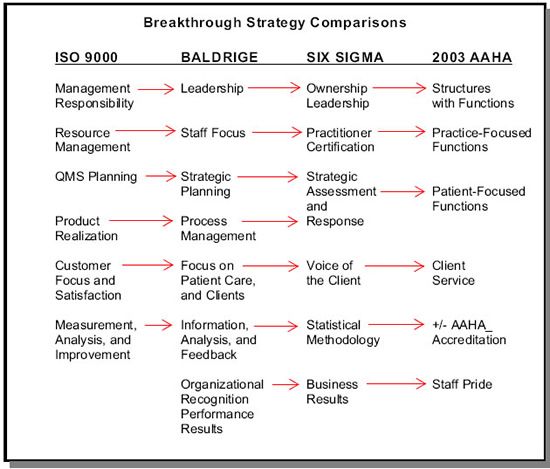The Practice Success Prescription: Team-Based Veterinary Healthcare Delivery by Drs. Leak. Morris Humphries
Thomas E. Catanzaro, DVM, MHA, FACHE, DACHE
The foundation of the practice plan is as essential as the measurements of improvement. With less than twenty percent of the veterinary practices in North America subscribing to AAHA for external monitoring of their quality healthcare delivery, it is often a breakthrough just to establish the baseline standards of care as inviolate expectations in a multi-doctor practice. In a multi-owner practice, the owners and managers need to work through the tools and procedures contained in the VCI® Signature Series Monograph Leadership Action Planner to ensure the core values, mission focus, and vision are not only held in common, but have also been shared with the team. These "commonly held" core values, mission focus, and vision must be based on five to ten years in the future, not the mistakes of yesterday.
Getting a set of the AAHA Standards for Accreditation does not commit you to subscribing to the AAHA survey system, but it does give the staff of your practice a set of guidelines from which to start. Then obtain a set of the ISO 9000 - IWA 1 standards, then task each hospital zone coordinator to use the zone team to combine and refine the two sets of standards. Over a thirty-day period, the zone coordinator organizes and facilitates the zone team in combining the two sets of standards. Meanwhile, three key "change model" things are occurring:
1. They are becoming aware of the things they are not doing (discomfort) and are writing the things that they should be accomplishing (model).
2. They are all participating in developing the new model(s) (desire to change).
3. The zone coordinator is assuming the role of a Green Belt implementation specialist, while the practice manager is assuming the role of a Black Belt (mentor for success), and the practice leadership is reinforcing the process as Sponsors, Champions, and Master Black Belts.
Once there is a common set of practice-tailored standards by zone, the zone coordinators meet with the practice manager, the Black Belt of Six Sigma changes. The standards are combined into a single set of hospital "standards for change". It is as this point when the newly revised, program-based, income centers budget must be integrated to ensure the resources required are funded. The zone coordinators, now the Green Belts for Six Sigma change, can see the cause and effect of the programs and improvements on the potential liquidity. Staff compensation and benefits are two budget line items that need to be tied to a percentage of the practice gross. As the gross increases, so do the available dollars in that budget line item. The budget will be reviewed quarterly by the zone coordinators (Green Belts), and adjustments addressed.
The reality of this entire concept is that it will change the practice culture. It will chase away some "And this, too, shall pass" staff members, because once started, it cannot be reverted to the old paradigms. The old paradigms linked to "We have always done it this way" will prove to be income reducers, and the new statistically based improvements will prove to be beneficial for clients and patients, the core reason most all of the staff and doctors entered this profession. This will be the trip into the future, and it will be exciting. The knowledge and experience "voids" will appear on your horizon and you will need to seek a guide, usually called a consultant or subject matter expert. Do not go it alone when you do not need to. Have a fun trip, and celebrate the discoveries regularly!
| Figure 21: Breakthrough Strategy Comparisons | 
|
|
| |